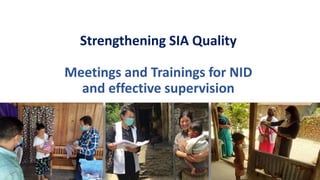Meetings and Trainings for NID 2024.pptx
- 1. 1 Strengthening SIA Quality Meetings and Trainings for NID and effective supervision
- 2. NID Planning Meeting ŌĆó Face to face meetings are better for interactions, coordination and learning ŌĆó Virtual or face to face district workshop to be facilitated by Civil Surgeon/ DIO, with support from SMO-NPSP and other partners ŌĆó Participation of MO I/Cs of all planning units ŌĆó Key discussion points ŌĆō Timeline of activities ŌĆō DTF, microplanning, trainings, procurement of logistics ŌĆō Key challenges ŌĆō Way ahead 2
- 3. 3 District Task Force Meetings ŌĆó District Task Force should be activated in all districts ŌĆó Should meet before the NID ŌĆó DM to chair the meeting with participation of ŌĆō District health officials CMO/CMHO, DIO, DPM ŌĆō CDO, SDMs, BDOs, Block MOs ŌĆō District level officers from ŌĆó ICDS, Education, Social welfare, PRI, Transport, Railways, Information (District Information Officer) ŌĆō Social Mobilization Network Partners, Rotary, IAP, IMA, Medical Colleges, NGOs, etc. ŌĆō Community and Religious leaders
- 4. 4 DTF Meeting ŌĆó SMO/CMO/DIO to present feedback from previous SIA rounds ŌĆó Review performance of each block/urban area and district as a whole ŌĆó Review involvement and coordination of other departments ŌĆó Social Mob efforts, Transport mobilization ŌĆó Share strategy and preparedness for NID ŌĆó Booth + HtH or exclusive HtH activity ŌĆó Availability of vaccinators; status of trainings ŌĆó Identify actions required ŌĆó DIO to document minutes with action points, persons responsible and timeline by which activity would be completed
- 5. 5 Organize Block / Tehsil Task Force Meetings for Inter-sectoral Coordination ŌĆó Block /Tehsil Task Forces to be established under the chairmanship of SDM/BDO ŌĆó Participants: Medical Officers, Officials from ICDS, Education, Revenue, Panchayati Raj Institutions, local NGOs & community leaders ŌĆó BTF/TTF shall also discuss regularly to: ’ā╝Review progress ’ā╝Ensure completeness and timely implementation of activities ŌĆó Role of district administration: ’ā╝Participate in BTFs, bring up issues of coordination like manpower deployment, transport etc for discussion ’ā╝Ensure meeting is organized before the round and minutes prepared for follow up actions
- 6. 6 Microplanning and manpower identification ŌĆó Microplan modifications may be needed in view of COVID situation ŌĆó Availability of vaccinators may be altered ŌĆó Closure of schools/ colleges ŌĆó Details given in presentation on Microplanning
- 7. 7 Supervisory Plans ŌĆó Develop supervisory/monitoring plans for ’ā╝Sector PHC/additional PHC MOs ’ā╝District medical officers/Dy CMOs ’ā╝District/Bock administration officers ’ā╝Supervisory/Monitoring plans by state officers ŌĆó Plans for evening feedback meetings/recording & reporting ŌĆó Plans for monitoring & feedback through independent monitors by partners
- 8. 8 Planning Vaccinator & Supervisor Trainings ŌĆó Plan for training of all vaccinators, focus on new volunteers ŌĆó Identify if training will be virtual or face to face ŌĆó Ensure physical distancing ŌĆó Complete all trainings/ catch up sessions 4-5 days before start of SIA activity ŌĆó Decentralize training venues to increase attendance - sessions at addl. PHCs/ Community centers, etc. ŌĆó Batch size ideally should not exceed 40 participants ŌĆó Details in following presentation
- 9. 9 Organize Evening Feedback Meetings & Ensure Timely Corrective Actions ŌĆó Block/PHC Medical Officer to organize daily evening meetings with supervisors and monitors along with other participating departments ŌĆó If face to face meeting, ensure physical distance and wearing of mask/ face cover ŌĆó During evening meeting give feedback to supervisors & MOs on polio vaccination activities ’ā╝Areas not covered well ’ā╝Areas with coordination problems ’ā╝Areas with operational problems ŌĆó Discuss and ensure mid- course corrections to solve problems seen in field ŌĆó If missed areas or > 3 False Ps are detected by a monitor or supervisor, the activity has to be repeated in the area of the team concerned
- 10. Format for Tracking of Missed Areas ŌĆó District data to be filled and displayed in this format 10 Areas detected with missed children ŌĆō March 2024 NID Name of District/State District Block/Urban Area No. of Missed Houses/Children Reasons Actions Taken/ Comments
- 11. 11 Monitoring and Supervision by Officials ŌĆó During preparatory phase ’ā╝ Review microplanning, training, social mobilization and other interventions ’ā╝ Provide feedback to block and district task forces ŌĆó During the booth & HTH activities ’ā╝ Monitor to assess quality of implementation ’ā╝ Provide feedback in evening review meetings and guide mid course corrections ŌĆó SDMs, ADMs, and BDOs to be involved in planning and supervision ŌĆō should be responsible and accountable for specific areas
- 12. Mar 2024 NID: Proposed Timeline of Activities ŌĆó District NID workshop : Early FebŌĆÖ 24 ŌĆó District Task Force meeting : 1 ŌĆō 4week of FebŌĆÖ 24 ŌĆó Micro plan review & manpower identification : complete by 3rd week of FebŌĆÖ 24 ŌĆó Vaccinator/ supervisor trainings : 3 and 4 Week of FebŌĆÖ 24 ŌĆó Release of funds & logistics to blocks : 3 and 4 Week of FebŌĆÖ 24 ŌĆó Intensify social mobilization activities : 4 week of Feb and 1 week of MarŌĆÖ 24 ŌĆó Launch of NID : 3 March 2024 ŌĆó Report Coverage and bOPV stock position : Within 3 days of completion of NID
- 13. 13 Dec 2023 SNID: Key Actions ŌĆó During NID, ensure maximum coverage, with focus on high-risk areas ŌĆó Ensure physical distancing and use of mask/face covers by vaccination teams ŌĆó Following NID, ensure ŌĆó routine immunization of beneficiaries in high-risk areas ŌĆó Track, rationalize and report bOPV stock position at all levels after NID ŌĆó Maintain high levels of AFP Surveillance sensitivity to detect any cVDPV or WPV importations
- 14. ’ā╝Presentation must be followed by discussion on key local issues requiring state/district level interventions & guidance ’ā╝Check all dates in presentation to align with NID dates in the respective state/ district 14 Add slides based on feedback / findings from previous polio campaigns














